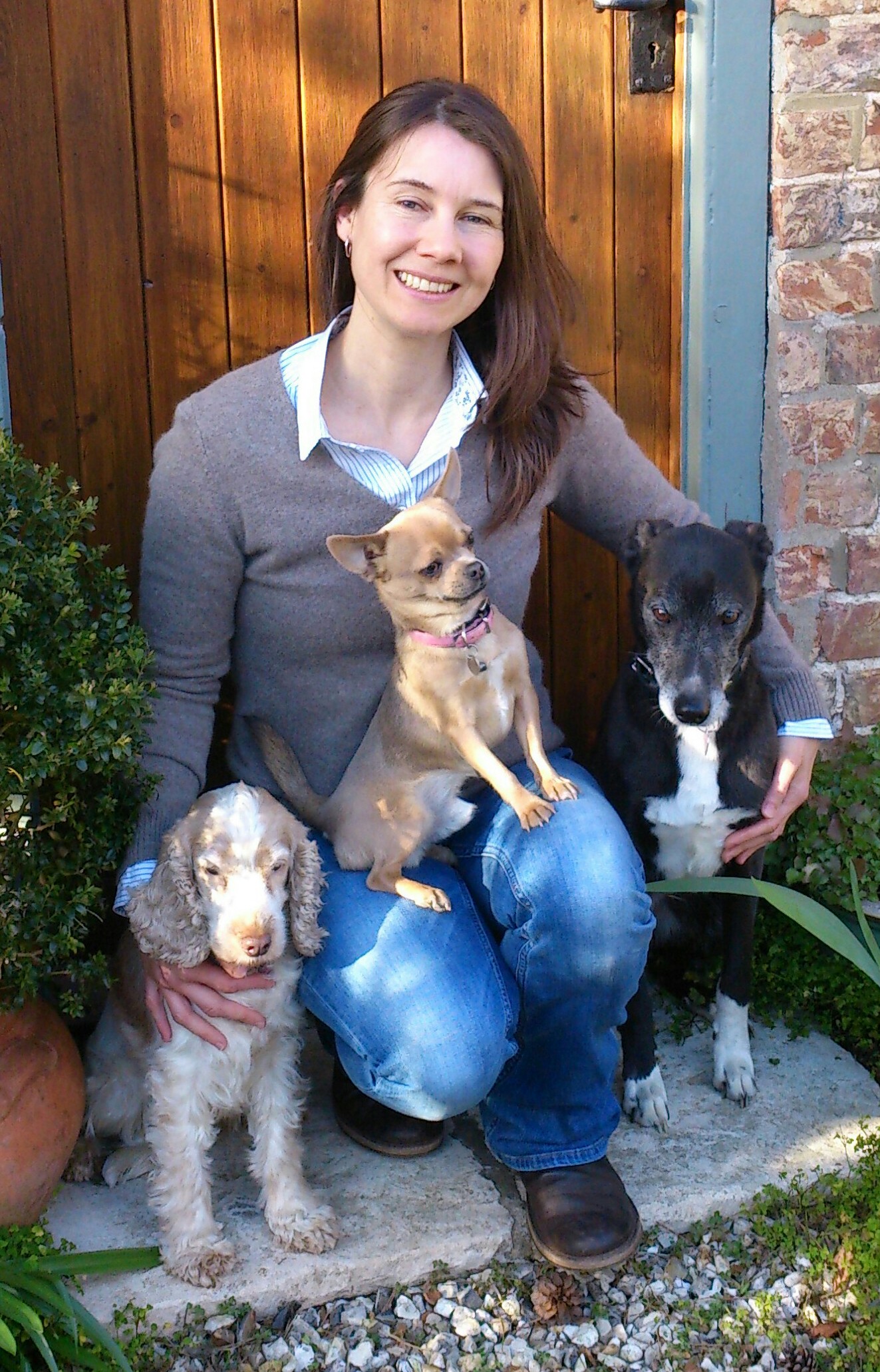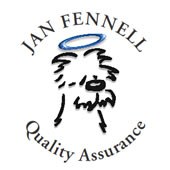Welcome to dogs in translation
Is your dog reacting negatively towards other dogs? Does he start pulling excessively when he sees another dog approaching? Perhaps he’s barking, whining and jumping around in a frantic manner or maybe he lunges and growls? Some dogs appear fine initially and then start growling and lunging after a few seconds of sniffing. Many dogs haven’t learnt to interact with other dogs in a calm and well-balanced manner. Instead they are heightened and over-the-top causing other dogs to panic and potentially react aggressively.
Or, perhaps your dog is anxious around people? Does she get into an extremely heightened state and bark excessively when people come to the door? Do people have to be wary when they come into your home? Perhaps you have to put your dog into another room because she’s just too unpredictable to be around visitors. Or maybe you can’t let her off the lead when you’re out for a walk, because she might chase after a runner, a cyclist or even a car!
Hi, my name is Lucy Parkes and I’m a Recommended Dog Listener and Trainer affiliated with the world-renowned author and original Dog Listener – Jan Fennell.
I’ve been a professional Dog Listener for over 17 years now, sharing Jan Fennell’s incredibly effective, kind, positive and holistic approach to living and working with dogs with people in and around Norwich and Norfolk (read my story here) I’ve worked with thousands of dogs and their humans all over East Anglia to help resolve problem behaviour ranging from excessive pulling on the lead and general lack of cooperation, through to reactivity and aggression towards other dogs, people and other animals, separation anxiety and other serious behavioural issues.
Why Dogs Need a Leader – Parent, Provider, and Protector
Similar to their wild ancestors, dogs flourish in environments that provide structure and clearly defined roles within their social group. In a domestic context, this necessitates the human family assuming the role of leader, encompassing responsibilities as parent, provider, and protector. This leadership role is essential for ensuring a dog’s well-being, behaviour, and overall happiness. Please click here to discover the importance of adopting the Leader – parent, provider, and protector framework for the benefit of our canine companions.
Did you know?
Many – if not most – behavioural issues in dogs are rooted in generalised anxiety and overwhelm and by understanding the world from your unique dog’s perspective and communicating leadership (parent, provider, protector) in a way that they can easily understand, you relieve them of that anxiety and overwhelm and help them to live their best lives. By advocating for your dog, especially as you head out into the wider world, you ensure that their tolerance for stress and stimulus is not exceeded and that they remain happily within their ‘feeling safe’ threshold, around other dogs, people and traffic.
Feeling unsafe, within and outside of the home, can manifest as reactivity, aggression, hyper-activity, separation anxiety, lack of cooperation and compulsive and undesirable patterns of behaviour in your dog.
Your dog isn’t being naughty!
It’s VERY important to understand this.
Because our dogs can’t speak to us and explain what’s going on for them, their feelings of fear, confusion, overwhelm and anxiety are communicated via ‘behaviour’. So if your Cockerpoo is stealing your things and refusing to give them back or your Dachshund is barking at you and driving you mad or your German Shepherd is barking at the visitor or your Romanian rescue has actually nipped the visitor (who now won’t visit your home) or your French Bulldog is turning his nose up at the expensive food you bought him AGAIN! It’s not because they’re deliberately trying to irritate you, wind you up or drive you mad!! They’re actually trying to communicate something to you and once you understand what these behaviours mean, you can effectively communicate back again and help your dog to relax, defer and step down. This will allow you to ‘step up’ and gently and kindly take control when you need to.
You’ll understand why your Boxer is SO bouncy, your Cocker Spaniel can’t stop resource guarding and your Golden Retriever pulls SO hard on the lead! It will become clear why your Border Collie is hyper-focused and hyper-aroused ALL of the time, why your terrier is so controlling and demanding and you’ll be able to guide your Doberman away from reactivity towards other dogs. You’ll be relieved to relieve your Chihuahua of relieving themselves in the house! That’s a lot of relief!! And you’ll be overjoyed to lead your English Springer Spaniel to a life of peace and harmony 🙂
Whatever the issues, whatever the breed and whatever the past experiences – you and your dog can have a bright and beautiful future together once you understand the world from their perspective and gain their trust, respect and cooperation by communicating with them in their own language.
Dogs Like This!
Perhaps you’ve been thinking – “I’ve had dogs all my life but I’ve never had one like this!” ??
Or maybe this is your first dog and even though you did lots of research and went to puppy training classes some undesirable behavioural issues are beginning to appear on a rather regular basis. Everyone is telling you that he/she will grow out of it but you’re not so sure and the much anticipated joy of bringing a young dog into your lives and home is diminishing.
Or you may have rehomed a ‘dog in need’. A Romanian Rescue dog, or a stray from Ireland, or a dog from one of our wonderful Dog Rescue Centres here in the UK. You’re finding that in spite of your best efforts the new addition to your family/pack is struggling to adapt to their new life and you’re all becoming increasingly more stressed and overwhelmed.
Whatever the circumstances, I can help. And with seventeen years experience of working with dogs like this, there isn’t much that I haven’t come across and helped people with. Working with and learning from these dogs has given me a real insight into how they perceive the world and their place within it. They really are a bit different from the average dog and require a deeper understanding and a more specialised approach to help them live fulfilling and happy lives.
“BENEATH EVERY BEHAVIOUR THERE IS A FEELING. AND BENEATH EACH FEELING IS A NEED. AND WHEN WE MEET THAT NEED RATHER THAN FOCUS ON THE BEHAVIOUR, WE BEGIN TO DEAL WITH THE CAUSE NOT THE SYMPTOM” – ASHLEIGH WARNER, HOLISTIC FAMILY PSYCHOLOGIST
“Hello Lucy, just had to say thank you again for yesterday, it was a joy to meet you and I already appear to have two very happy little dogs. They are, for the most part, doing exactly as I ask and dinner last night was so different for us all. We have calm instead of chaos and we are all impressed, the change is astonishing! And the stair gate arrives tomorrow  Thanks ever so Lucy x”
Thanks ever so Lucy x”
(More client testimonials here . . . )
 Contact me now for an initial consultation where I will explain what’s going on for your dog and how I can help you to help him/her – 07951 328163 or 01603 881626
Contact me now for an initial consultation where I will explain what’s going on for your dog and how I can help you to help him/her – 07951 328163 or 01603 881626
For less serious behavioural issues I may be able to advise you over the phone. Sometimes all it takes is a ‘tweak’ to what you’re already doing and things can fall into place . . .
If, however, your dog is exhibiting any of the more significant behavioural issues listed below, it is likely that I will recommend a one-to-one consultation where I come and work with you, your dog/s and any other family members, in your home, and initiate a process that you then continue to implement. I effectively get things going in the right direction and it’s rare for us not to see a positive shift and change in the dog’s behaviour on the day.
Significant behavioural issues requiring a one-to-one Home Consultation –
- Aggressive response towards other dogs, owners, other people, traffic or anything else.
- Separation anxiety and distress
- Extreme lack of cooperation – poor recall, excessive pulling on the lead, hunting
- Hyperactivity and hyper-vigilance – hyperarousal
- Over-excitability (over-stimulation)
- Eating disorders – control eaters (fussy eaters) refusing to eat or constantly obsessed with the search for food. Coprophagia (eating faeces)
- Self-harming – paw/tail/leg chewing, obsessive licking/cleaning
- Obsessive/compulsive behaviours – tail chasing, fixations, boundary running, resource guarding
- Excessive fear response to thunder, fireworks or any other stimulus.
“Hi Lucy.
I can’t thank you enough for coming to spend the day with us and Dudley. We learnt so much and everything just clicked into place, as to why Dudley was behaving in certain ways. It is so reassuring to also know that I can message/call/email you when I have a question (no matter how big or small).We have seen such a positive change in Dudley in the short time of just a week. He has been eating his food again, and appears to be much happier and relaxed and so are we. (I haven’t cried over his behaviour since you came to see us!)
I just wish we had found you sooner!
Thank you so much”
I share with you how to become an inspirational leader – parent, provider, protector. This is what underpins a successful relationship and forms the foundations for a calm, well-balanced and cooperative dog.
. . . and it’s not about domination, punishment, coercion, bribery, distraction or excessive training – it’s all about building a relationship of mutual trust, respect and cooperation. If your dog trusts and respects you she will choose to cooperate with you to the best of her ability. If you lead by example and calmly and gently show your dog what you would like from her, in any given situation, you find that – over-time – she adopts this new way of being as her own.
Our dog’s do not want to be in conflict with us or each other! Given the choice – the right information – and managed in the correct way, the very vast majority of dog’s are happy to relinquish control and accept our guidance and support. As pack animals it’s in their nature to do so.
. . . and I don’t leave you alone to cope with the inevitable ups and downs in your journey to canine harmony. After the initial consultation I support you every step of the way, as often as you need it, via telephone and email and this is included in the initial payment.
“Hi Lucy,
I know it’s only day 3 but I couldn’t resist emailing you to tell you what a difference I have seen in the dogs already – I can’t thank you enough! Both are responding incredibly well to the thanking them and looking out of the window for danger – I’m amazed! . . . I’m just so impressed that things have begun to change already and I wish we had been recommended you sooner!!”
 Are you having problems with your best friend? Is he refusing to play ball? There are no ‘problem’ dogs but there are dog’s with problems and some dog’s have some very big problems! But there’s NO problem too big for me to help you with, as long as together we can create the right environment for your dog to thrive in!
Are you having problems with your best friend? Is he refusing to play ball? There are no ‘problem’ dogs but there are dog’s with problems and some dog’s have some very big problems! But there’s NO problem too big for me to help you with, as long as together we can create the right environment for your dog to thrive in!
“Hi Lucy,
It’s been a month since you visited and we continue to be delighted with the behaviour of our dogs since our training. We were experiencing issues with our male dog Milo, who had begun to act differently by showing signs of aggression towards us and other dogs. Through the techniques you shared with us such as; changing the dogs schedules and how we as pack leaders interact with our dogs we saw an immediate change in their behaviour. This change started 2 hours after you had arrived and continued from then on. Both dogs are calm, relaxed and a pleasure to be around, they also respond to commands much better than before . . . our friends are no longer overwhelmed by Milo on arrival, indeed the most common line from friends to our home being “They are like different dogs”.
We can’t thank you enough for your patience with the array of questions you had to answer from us and the continued support you offer. Dogs in Translation came highly recommended by a work colleague and having now been through the training experience ourselves we would confidently recommend Dogs in Translation to any dog owner. Thanks again”
(More client testimonials here . . . )
Understanding, communication and cooperation ~
The first step to resolving undesirable behaviour in your dog, is to understand what it is that your dog is trying to achieve. What is his motivation? Understanding the world from your dog’s perspective is essential for the effective long-term resolution of problem behaviour. It’s not just about dog training.
Dog training can form an important part of your dog’s education but by far the most important consideration is how you LIVE with your dog. Your daily interactions with your dog shape his personality – his responses, emotions and capabilities. Whether he’s a puppy or an older dog from another home, or a rescue centre, you shape his perceptions and reactions to the world around him – either consciously or unconsciously – through what you expose him to and what you do and how you do it!
When we are consciously shaping our dog’s behaviour, we can help him to feel safe and secure at all times. Whether we are at home or out in the wider-world, we can encourage our dogs to look to us and trust our decisions about – and responses to – the things that we encounter. Other dogs, people, traffic, loud noises and other challenging stimulus, can all be managed calmly and effectively leading to the respect and cooperation that we all desire!
When we are unconsciously shaping our dog’s behaviour, it’s all to easy to inadvertently, nurture insecurity and fear, and condition our dogs to respond in an undesirable way to the world around them! Many of the behavioural problems that dog owners experience with their dogs, can be swiftly resolved, when we become more conscious of just how we shape our dogs!
Living with dogs can be an absolute joy or a complete nightmare and it’s HOW we live with them makes all the difference! Some of you will have dogs who pull badly on the lead! Some of you will have dogs who are showing aggression towards other dogs and/or people! And some of you will have dogs who are suffering from separation anxiety! All of these problems, and more, are the result of miscommunication and misunderstanding and can be resolved once you understand the world from your dog’s perspective and begin the process of calmly and consistently communicating to your dog that all is well and that he can trust you with pack safety!
What does your dog believe he is doing and why is he doing it?
A dog’s behaviour is often symbolic, they use ritualised behaviour to convey information to each other – and us! If we don’t understand what a dog’s behaviour really signifies – and it is very easy for us to misinterpret as we tend to anthropomorphise (humanise) – we are likely to misunderstand and miscommunicate. The result can be problem behaviour –
- General lack of cooperation
- Pulling on the lead and poor recall
- Hyperactivity
- Obsessive and compulsive behaviour *
- Separation anxiety
- Excessive barking
- Destruction
- Problems around food
- Anxiety, fear and stress
- Aggressive behaviour **
* This can include – tail-chasing, biting and chewing paws and excessive self-grooming. Obsessive licking of objects and/or people. Constant pacing in the house and/or garden. Fixating on objects or people. Coprophagia (eating faeces).
** Aggression towards other dogs, is the number one behavioural problem that we are asked to help people with.
To find out how you can considerably reduce the risk of a puppy developing this – and any of the other issues mentioned above please click here Without understanding why a behavioural problem is occurring we are forced to treat the symptoms; gadgets and gizmos, obedience training, excessive exercising and the use of force, are all attempts to make your dog behave in a certain way – and very often they cause your dog more stress in the process!
Stress has a major impact on a dog’s behaviour, affecting him both mentally and physically! Stress can manifest in many ways and most of the behavioural problems mentioned above are associated with high levels of stress! Stress related behaviour is often misinterpreted as ‘high-spirited’ or ‘over-excited’ behaviour. Some dogs go the other way and will ‘shut down’ when they feel overwhelmed and unable to cope. Physical illness and disease can also be the result of stress. Autoimmune disease, skin allergies, irritable bowel, arthritis, diabetes and cancer – to mention a few – have all been linked to the effect of prolonged exposure to stress.
Dog Listening approaches the problem from a different angle.
Instead of trying to manage the symptoms alone, Dog Listening goes to the root of the problem. By changing the way that you interact with your dog on a daily basis, you can calmly and consistently give him information about leadership that will reassure him and allow him to begin to relax. It then becomes possible to guide and influence your dog’s behaviour in a kind and positive way – without the use of force, gadgets or gizmos – and resolve problem behaviour by re-shaping his conditioned responses.
By calmly and consistently implementing signals that your dog can actually understand, you can communicate with him in his own language, gain his cooperation and reduce everyone’s stress levels! A stressed and confused dog often results in a stressed owner! A vicious circle of stress can develop, with dog and owner feeding each others anxiety!
There are four simple steps to breaking this circle of stress and presenting yourself as the calm, confident Pack Leader that all dogs innately seek –
Four steps to successful Dog Training:
- Understand the world from your dog’s perspective –
The human world can sometimes be a confusing and threatening place. Understanding how your dog really feels about things and why he reacts in the way that he does, is pivotal to the resolution of problem behaviour. Understanding your dog’s innate needs and requirements enables you to provide for him in a way that helps him to feel safe and sound. - Learn his language –
Like all animals, dogs have a language of their own. It includes some vocalisation but is predominantly eye contact, body language and behaviour-based. The domestic dog has adapted and evolved to live alongside modern humans but still shares the same basic programming as his wild-living relative the wolf. - Communicate clearly –
Once we understand what our dog is trying to communicate to us, through his behaviour and body language, we can communicate back again in a way that is easily understood, and inspires trust, respect and cooperation. It is all to easy to misunderstand what a dog is communicating and to miscommunicate back again. - Calmly and consistently show him what you want –
Patience really is a virtue when working with dogs. Some dogs learn really quickly and will pick things up at the drop of a hat and others will have to be calmly shown many times, before they are able to adopt a new behaviour or way of doing things. Some dogs learn well in a group situation, others can find a group situation over-whelming and require one to one training in the safety of the home.
Develop the relationship with your dog that you both truly deserve.
Become a calm, confident and consistent Pack Leader and watch as your dog thrives in an environment that is fulfilling her unique requirements. Feel the joy that a calm, cooperative and well-balanced dog can bring to your life! In your home, show your dog – in a way that she can understand – that you are the provider, the one who makes the decisions and keeps the pack safe.
Teach your dog to calmly walk with you when you head out into the wider world – balanced, cooperative and responsive. Reassure her that as Pack Leader you will keep the pack safe from any perceived danger that you might meet out there, such as other dogs, people or traffic. As Pack Leader you lead by example and are able to resolve problem behaviour because your dog trusts and respects you. By letting your dog know that you and any other human pack members will take absolute responsibility for the pack, you allow her to relax and take a subordinate yet valued role in a happy and harmonious family group.

















